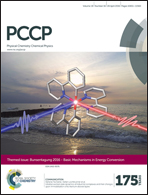Monte-Carlo modelling of nano-material photocatalysis: bridging photocatalytic activity and microscopic charge kinetics
Abstract
In photocatalysis, it is known that light intensity, organic concentration, and temperature affect the photocatalytic activity by changing the microscopic kinetics of holes and electrons. However, how the microscopic kinetics of holes and electrons relates to the photocatalytic activity was not well known. In the present research, we developed a Monte-Carlo random walking model that involved all of the charge kinetics, including the photo-generation, the recombination, the transport, and the interfacial transfer of holes and electrons, to simulate the overall photocatalytic reaction, which we called a “computer experiment” of photocatalysis. By using this model, we simulated the effect of light intensity, temperature, and organic surface coverage on the photocatalytic activity and the density of the free electrons that accumulate in the simulated system. It was seen that the increase of light intensity increases the electron density and its mobility, which increases the probability for a hole/electron to find an electron/hole for recombination, and consequently led to an apparent kinetics that the quantum yield (QY) decreases with the increase of light intensity. It was also seen that the increase of organic surface coverage could increase the rate of hole interfacial transfer and result in the decrease of the probability for an electron to recombine with a hole. Moreover, the increase of organic coverage on the nano-material surface can also increase the accumulation of electrons, which enhances the mobility for electrons to undergo interfacial transfer, and finally leads to the increase of photocatalytic activity. The simulation showed that the temperature had a more complicated effect, as it can simultaneously change the activation of electrons, the interfacial transfer of holes, and the interfacial transfer of electrons. It was shown that the interfacial transfer of holes might play a main role at low temperature, with the temperature-dependence of QY conforming to the Arrhenius model. The activation of electrons from the traps to the conduction band might become important at high temperature, which accelerates the electron movement for recombination and leads to a temperature dependence of QY that deviates from the Arrhenius model.


 Please wait while we load your content...
Please wait while we load your content...